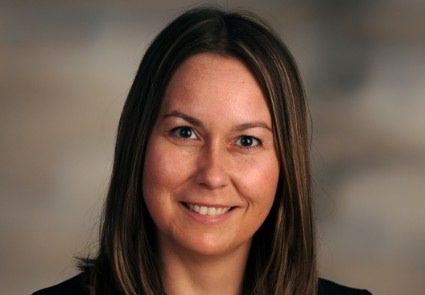User login
ORLANDO – A novel combination of aortic root remodeling and aortic valve bicuspidization helped prevent the need for surgery in young adult patients with unicuspid aortic valve anatomy and root dilatation, according to Dr. Diana Aicher.
Though unicuspid aortic valve (UAV) anatomy is rare, about 60% of affected patients require aortic valve surgery before 20 years of age owing to aneurysm of the aortic root. Aortic root remodeling and aortic valve bicuspidization allow for good aortic valve hemodynamic function, and in most patients with aortic regurgitation due to UAV and root aneurysm, the surgical procedure obviates the need for aortic valve replacement, Dr. Aicher reported at the annual meeting of the Society of Thoracic Surgeons.
Of 25 patients with aortic regurgitation due to UAV and aortic root dilatation who underwent the procedure between August 2001 and August 2012, 84% were free from reoperation and 91% were free from aortic valve replacement at 5 years of follow-up, said Dr. Aicher of Uniklinikum des Saarlandes, Homburg, Germany.
Intraoperative echocardiography revealed minimal (stage 1) aortic regurgitation in 8% of patients and no aortic regurgitation in 92% of patients. The systolic peak gradient was 14 mm Hg.
No early or late deaths occurred following surgery, and there was no bleeding or thromboembolism. One patient developed endocarditis during follow-up, which was treated with antibiotics and reoperation for aortic regurgitation 2 months later, Dr. Aicher noted.
Three other patients required reoperation; two had relevant recurrent aortic regurgitation due to suture dehiscence and were reoperated on between 16 and 32 months after the initial procedure. One patient received a biological aortic valve replacement.
Patients included in the study were adults aged 21-65 years (mean age, 37.5 years). All were followed echographically at 3, 6, and 12 months, and then at yearly intervals for up to 141 months (mean, 42 months).
The findings suggest that in patients with UAV who develop aortic root aneurysm, a combination of valve bicuspidization – a procedure developed by Dr. Aicher and her team several years ago – and root remodeling can be used to treat both defects with a satisfactory result, she said.
The procedure involves resection of the dilated aortic root tissue, leaving two tongues at 180-degree orientation for the commissures. A new commissure is then created opposite the normal one, and cusp tissue is augmented by autologous pericardial patches. Dilation of the basal ring was corrected by suture annuloplasty in 16 patients.
The findings indicate that "in the presence of UAV and aortic root dilatation, the concept of valve bicuspidization and root remodeling can be applied with satisfactory hemodynamic results. Additional stabilization of the atrioventricular junction by a circumferential annuloplasty is an important complement to the repair strategy," Dr. Aicher said.
"Our repair strategy is an alternative to the current standard of care," she concluded.
Dr. Aicher reported having no disclosures.
ORLANDO – A novel combination of aortic root remodeling and aortic valve bicuspidization helped prevent the need for surgery in young adult patients with unicuspid aortic valve anatomy and root dilatation, according to Dr. Diana Aicher.
Though unicuspid aortic valve (UAV) anatomy is rare, about 60% of affected patients require aortic valve surgery before 20 years of age owing to aneurysm of the aortic root. Aortic root remodeling and aortic valve bicuspidization allow for good aortic valve hemodynamic function, and in most patients with aortic regurgitation due to UAV and root aneurysm, the surgical procedure obviates the need for aortic valve replacement, Dr. Aicher reported at the annual meeting of the Society of Thoracic Surgeons.
Of 25 patients with aortic regurgitation due to UAV and aortic root dilatation who underwent the procedure between August 2001 and August 2012, 84% were free from reoperation and 91% were free from aortic valve replacement at 5 years of follow-up, said Dr. Aicher of Uniklinikum des Saarlandes, Homburg, Germany.
Intraoperative echocardiography revealed minimal (stage 1) aortic regurgitation in 8% of patients and no aortic regurgitation in 92% of patients. The systolic peak gradient was 14 mm Hg.
No early or late deaths occurred following surgery, and there was no bleeding or thromboembolism. One patient developed endocarditis during follow-up, which was treated with antibiotics and reoperation for aortic regurgitation 2 months later, Dr. Aicher noted.
Three other patients required reoperation; two had relevant recurrent aortic regurgitation due to suture dehiscence and were reoperated on between 16 and 32 months after the initial procedure. One patient received a biological aortic valve replacement.
Patients included in the study were adults aged 21-65 years (mean age, 37.5 years). All were followed echographically at 3, 6, and 12 months, and then at yearly intervals for up to 141 months (mean, 42 months).
The findings suggest that in patients with UAV who develop aortic root aneurysm, a combination of valve bicuspidization – a procedure developed by Dr. Aicher and her team several years ago – and root remodeling can be used to treat both defects with a satisfactory result, she said.
The procedure involves resection of the dilated aortic root tissue, leaving two tongues at 180-degree orientation for the commissures. A new commissure is then created opposite the normal one, and cusp tissue is augmented by autologous pericardial patches. Dilation of the basal ring was corrected by suture annuloplasty in 16 patients.
The findings indicate that "in the presence of UAV and aortic root dilatation, the concept of valve bicuspidization and root remodeling can be applied with satisfactory hemodynamic results. Additional stabilization of the atrioventricular junction by a circumferential annuloplasty is an important complement to the repair strategy," Dr. Aicher said.
"Our repair strategy is an alternative to the current standard of care," she concluded.
Dr. Aicher reported having no disclosures.
ORLANDO – A novel combination of aortic root remodeling and aortic valve bicuspidization helped prevent the need for surgery in young adult patients with unicuspid aortic valve anatomy and root dilatation, according to Dr. Diana Aicher.
Though unicuspid aortic valve (UAV) anatomy is rare, about 60% of affected patients require aortic valve surgery before 20 years of age owing to aneurysm of the aortic root. Aortic root remodeling and aortic valve bicuspidization allow for good aortic valve hemodynamic function, and in most patients with aortic regurgitation due to UAV and root aneurysm, the surgical procedure obviates the need for aortic valve replacement, Dr. Aicher reported at the annual meeting of the Society of Thoracic Surgeons.
Of 25 patients with aortic regurgitation due to UAV and aortic root dilatation who underwent the procedure between August 2001 and August 2012, 84% were free from reoperation and 91% were free from aortic valve replacement at 5 years of follow-up, said Dr. Aicher of Uniklinikum des Saarlandes, Homburg, Germany.
Intraoperative echocardiography revealed minimal (stage 1) aortic regurgitation in 8% of patients and no aortic regurgitation in 92% of patients. The systolic peak gradient was 14 mm Hg.
No early or late deaths occurred following surgery, and there was no bleeding or thromboembolism. One patient developed endocarditis during follow-up, which was treated with antibiotics and reoperation for aortic regurgitation 2 months later, Dr. Aicher noted.
Three other patients required reoperation; two had relevant recurrent aortic regurgitation due to suture dehiscence and were reoperated on between 16 and 32 months after the initial procedure. One patient received a biological aortic valve replacement.
Patients included in the study were adults aged 21-65 years (mean age, 37.5 years). All were followed echographically at 3, 6, and 12 months, and then at yearly intervals for up to 141 months (mean, 42 months).
The findings suggest that in patients with UAV who develop aortic root aneurysm, a combination of valve bicuspidization – a procedure developed by Dr. Aicher and her team several years ago – and root remodeling can be used to treat both defects with a satisfactory result, she said.
The procedure involves resection of the dilated aortic root tissue, leaving two tongues at 180-degree orientation for the commissures. A new commissure is then created opposite the normal one, and cusp tissue is augmented by autologous pericardial patches. Dilation of the basal ring was corrected by suture annuloplasty in 16 patients.
The findings indicate that "in the presence of UAV and aortic root dilatation, the concept of valve bicuspidization and root remodeling can be applied with satisfactory hemodynamic results. Additional stabilization of the atrioventricular junction by a circumferential annuloplasty is an important complement to the repair strategy," Dr. Aicher said.
"Our repair strategy is an alternative to the current standard of care," she concluded.
Dr. Aicher reported having no disclosures.
AT THE STS ANNUAL MEETING
Major finding: At 5 years of follow-up, 84% of patients with unicuspid aortic valve anatomy were free from reoperation and 91% were free from aortic valve replacement.
Data source: A review of 25 cases.
Disclosures: Dr. Aicher reported having no disclosures.

